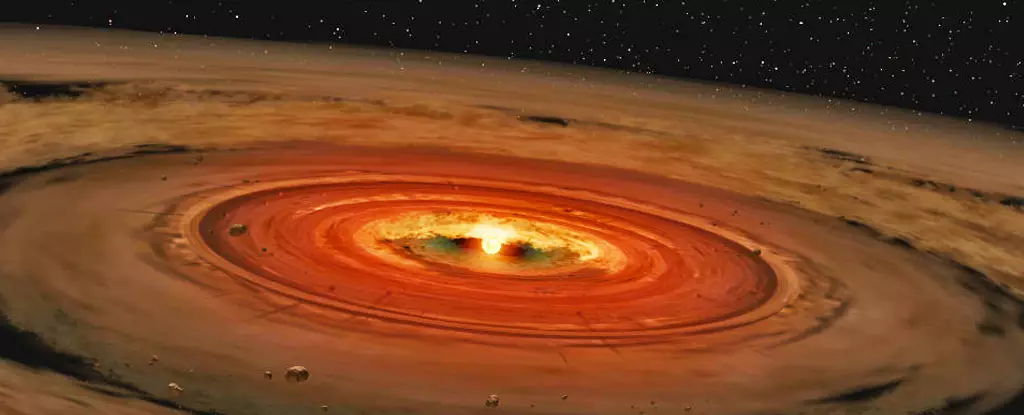Nestled approximately 1,000 light-years away from Earth lies a celestial marvel known as IRAS 23077+6707, which bears a striking resemblance to a colossal butterfly. This cosmic structure first caught the attention of Ciprian T. Berghea, an esteemed astronomer from the US Naval Observatory, back in 2016 through the lens of the Panoramic Survey Telescope and Rapid Response System (Pan-STARRS). Despite the passage of time, IRAS 23077 has retained its awe-inspiring form, prompting researchers to delve deeper into its mysteries.
Unlocking the Secrets of IRAS 23077
In a quest for understanding, two international teams of astronomers embarked on a journey to investigate IRAS 23077 further. Employing the Submillimeter Array at the Smithsonian Astrophysical Observatory (SAO) in Hawaii, these teams sought to shed light on the enigmatic cosmic structure. Through a series of meticulous observations and analyses, a groundbreaking revelation emerged – IRAS 23077 is not merely a cosmic oddity but a young star enveloped by an expansive protoplanetary debris disk, unparalleled in its size.
The discoveries made by these astronomical teams have not only broadened our comprehension of planet formation but have also illuminated the intricate environments in which this phenomenon unfolds. The initial paper, spearheaded by Berghea, unveiled the youthful nature of IRAS 23077, situated at the core of what appeared to be a colossal planet-forming disk. Subsequently, in a second paper led by Kristina Monsch, a postdoctoral researcher at the CfA, the confirmation of this protoplanetary disk using data from Pan-STARRS and the Submillimeter Array was documented.
Protoplanetary disks serve as vital conduits in the cosmic symphony of planetary birth, comprising the celestial cradles where gas and dust congregate around nascent stars. Over epochs, these disks metamorphose into ring structures, nurturing the development of protoplanets in distinct orbital paths that pave the way for the formation of diverse planetary bodies – ranging from rocky planets to gas giants and icy worlds. Astronomers leverage these disks to ascertain the dimensions and masses of young stars, as these disks exhibit characteristic rotational patterns.
Despite their significance, precise observations of these protoplanetary disks can be hindered by their positioning relative to Earth. While some disks are oriented face-on, rendering them observable in their entirety, others – like IRAS 23077 – present themselves edge-on, concealing the parent star’s radiance. Nonetheless, the telltale dust and gas signatures of these disks emanate prominently at millimeter wavelengths, a phenomenon leveraged by the Submillimeter Array to peer into the cosmic tapestry.
Upon scrutinizing IRAS 23077 through the combined observational prowess of Pan-STARRS and the Submillimeter Array, astronomers were greeted with a spectacle that defied conventional expectations. Kristina Monsch, the driving force behind the SMA campaign, recounted the astonishment that accompanied their findings during a recent CfA news release. The cumulative data from the SMA unequivocally affirmed the entity as a protoplanetary disk swirling around a star surpassing the mass of our own Sun.
The discovery of IRAS 23077, affectionately dubbed “Dracula’s Chivito” in homage to its cryptic allure, has stirred contemplation and curiosity within the scientific community. As Lovell emphasized, the unveiling of such an extended and luminous structure opens the doors to a realm teeming with possibilities. Delving deeper into the intricacies of IRAS 23077 may unveil new pathways to unravel the enigmas of planet formation in extreme conditions, thus broadening our horizons regarding exoplanetary systems.
Charting New Frontiers in Planetary Exploration
The revelation of IRAS 23077 does not merely stand as a solitary discovery but beckons astronomers to embark on a quest for similar cosmic entities within our galactic neighborhood. By peering into the earliest stages of planetary genesis, these observations hold invaluable insights that may illuminate the enigmatic origins of our own Solar System. The Submillimeter Array, a collaborative effort between the SAO and the ASIAA, stands as a beacon guiding our endeavors to unravel the cosmic mysteries enveloping us.


Leave a Reply